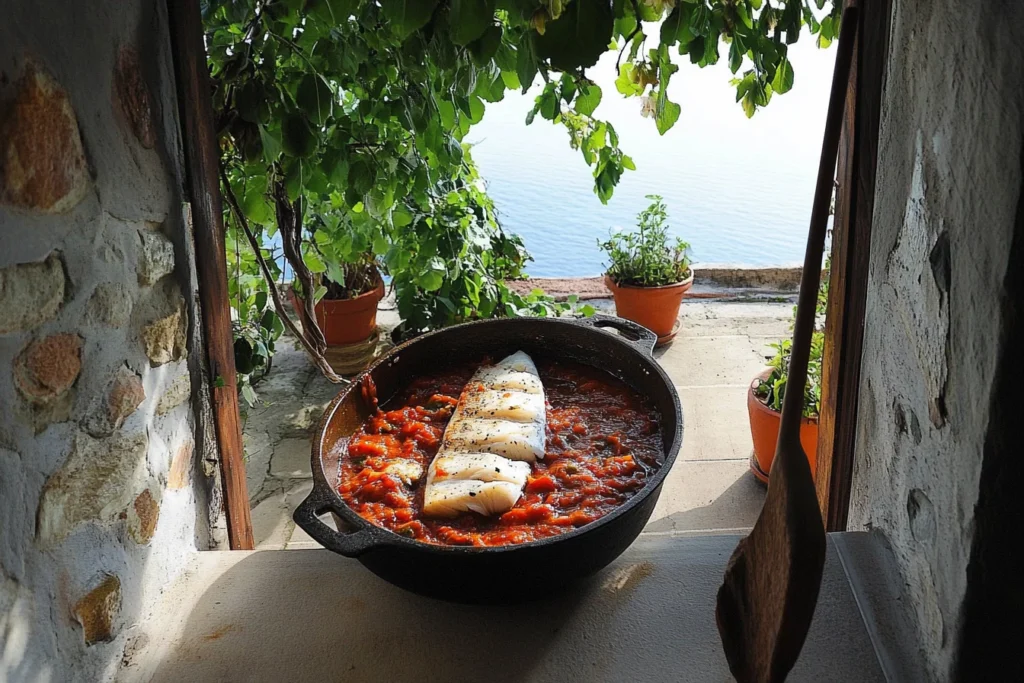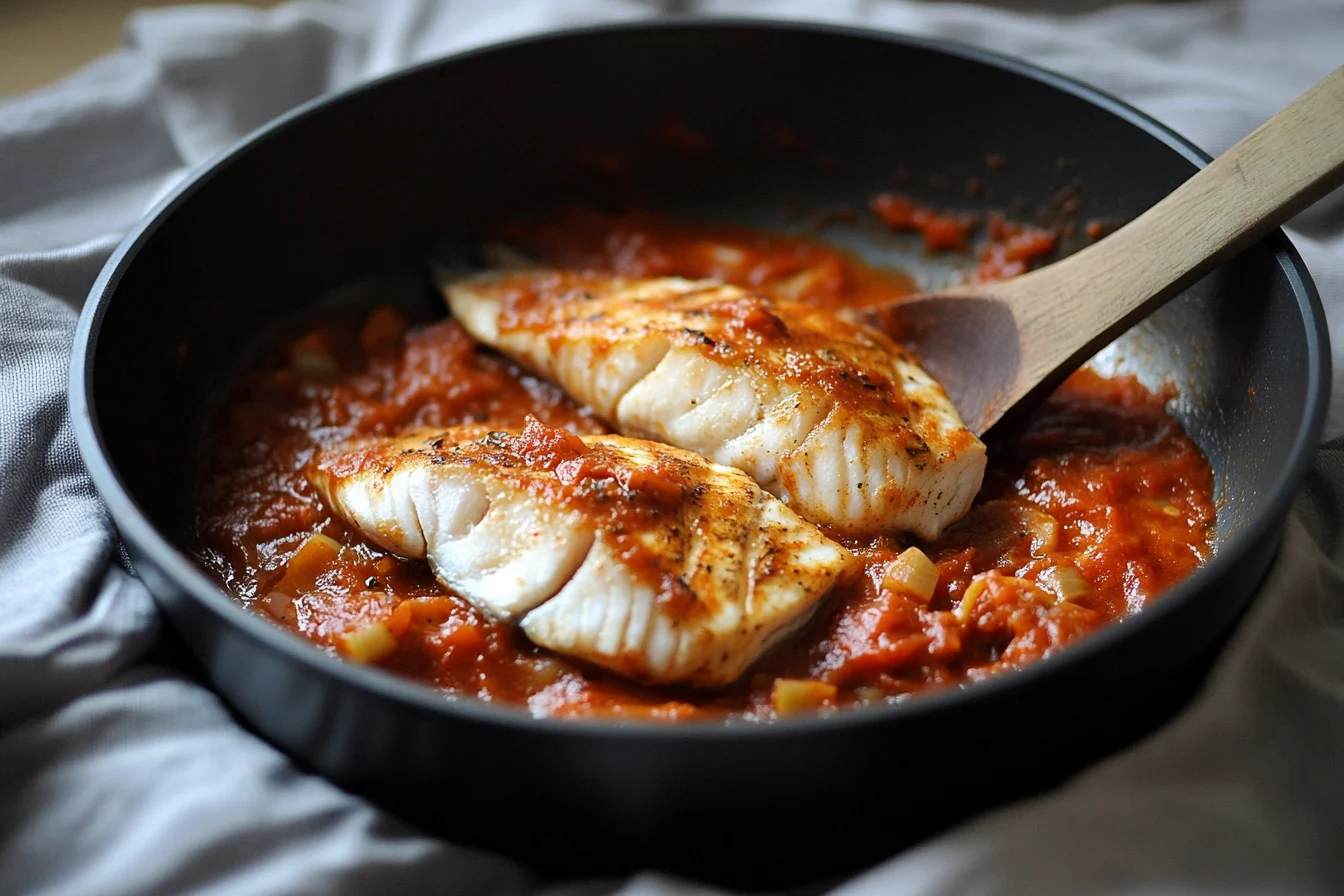Introduction to Halibut Marinara Sauce Recipe
If you’re on the lookout for a flavorful seafood recipe, Halibut Marinara Sauce is an irresistible option. This dish perfectly combines the delicate, buttery texture of halibut with the rich, tangy flavor of marinara sauce. Whether you’re planning a romantic dinner or a family meal, this recipe offers the perfect blend of health and gourmet appeal.
Why choose halibut? Its firm texture and mild flavor make it ideal for soaking up the vibrant marinara sauce. In this guide, you’ll learn how to prepare this dish step-by-step, ensuring perfect results every time.

What Makes Halibut a Perfect Match for Marinara Sauce?
The combination of halibut and marinara sauce is culinary magic. The mild sweetness of the fish pairs well with the acidity and aromatics of the sauce, creating a balanced, mouthwatering dish. The versatility of halibut allows it to be prepared in several ways, from pan-searing to baking or even grilling.
- Nutritional Perks: Halibut is rich in omega-3 fatty acids, high-quality protein, and essential vitamins, making it a healthy choice for seafood lovers.
- Marinara’s Bold Flavors: This classic Italian sauce, made with tomatoes, garlic, and herbs, enhances the halibut without overpowering its natural flavor.
For a deep dive into marinara sauce’s nutritional and culinary benefits, check out this article.
Key Features of This Recipe
Here’s why you’ll love this recipe:
- Easy-to-Follow: Perfect for beginners and experienced cooks alike.
- Customizable: Adjust the spice level, cooking method, or pairings to suit your taste.
- Diet-Friendly: Naturally gluten-free, with options for dairy-free and low-carb modifications.
Essential Ingredients for Halibut Marinara Sauce
Fresh Halibut: How to Choose the Best Cut
The quality of halibut directly impacts the dish’s outcome. Look for these signs of freshness when purchasing:
- Firm Flesh: Fresh halibut should be firm to the touch and bounce back when pressed.
- Mild Aroma: Avoid fish with a strong or “fishy” smell.
- Clear Eyes (if whole): Indicate freshness.
You can substitute halibut with other white fish like cod or snapper for a budget-friendly option.
The Heart of the Dish: Marinara Sauce Ingredients
To make a robust marinara sauce, you’ll need:
- Tomatoes: Choose high-quality canned tomatoes for convenience or fresh, vine-ripened tomatoes for authenticity.
- Aromatics: Garlic and onions form the flavor base of the sauce.
- Herbs: Fresh basil, oregano, and thyme elevate the dish’s aromatic profile.
- Olive Oil: Provides richness and depth of flavor.
- Optional Spice: Red pepper flakes for a subtle kick.
Canned Tomatoes vs. Fresh Tomatoes: Which to Use?
- Canned Tomatoes: Convenient and consistent in quality, ideal for quick recipes.
- Fresh Tomatoes: Offer a more vibrant flavor but require peeling and seeding for best results.
For a comprehensive breakdown of tomato types, read this guide.
The Role of Aromatics: Garlic, Onions, and Herbs
The secret to a rich marinara sauce lies in properly sautéing the aromatics. Garlic and onions should be cooked until translucent and fragrant, creating the base for the sauce. Fresh herbs are added towards the end to preserve their bright flavor.
Optional Ingredients for Extra Flavor
To take your dish to the next level, consider these additions:
- Capers or Olives: Add a briny contrast.
- Anchovy Paste: Deepens the umami flavor without tasting “fishy.”
- Splash of White Wine: Enhances the sauce’s complexity.
Substitutions and Dietary Adjustments
- Low-Carb/Keto: Replace sugar in marinara sauce (if used) with a low-carb alternative like erythritol.
- Dairy-Free: Skip parmesan and garnish with fresh herbs.
- Vegetarian Alternative: Substitute halibut with firm tofu or eggplant for a plant-based twist.
Step-by-Step Preparation
Cooking Halibut Marinara Sauce is a delightful culinary journey. Let’s break it down into simple, actionable steps to ensure your dish turns out perfect every time.
Preparing the Halibut for Cooking
The success of this dish begins with properly preparing your halibut. A clean, well-seasoned fillet is the foundation for flavor.
Cleaning and Trimming the Fish
- Rinse: Gently rinse the fillet under cold water to remove any surface debris.
- Pat Dry: Use paper towels to pat the fillet completely dry. Excess moisture can prevent proper browning.
- Inspect: Check for pin bones by running your fingers over the flesh. Use tweezers to remove any you find.
A well-trimmed halibut fillet ensures even cooking and a smooth texture.
Seasoning Techniques for Maximum Flavor
Proper seasoning brings out the best in halibut’s natural flavor:
- Base Seasoning: Generously sprinkle both sides with kosher salt and freshly ground black pepper.
- Optional Enhancements: Rub with a pinch of garlic powder, paprika, or lemon zest for added depth.
Allow the seasoned fillet to rest for 10–15 minutes. This helps the flavors penetrate the fish.
Making the Perfect Marinara Sauce
The marinara sauce is the star of this recipe. A good sauce requires patience and a few simple techniques to bring out its depth of flavor.
Step 1: Sautéing the Aromatics
- Heat the Pan: Warm 2–3 tablespoons of olive oil in a medium skillet over medium heat.
- Cook Aromatics: Add finely chopped onions and sauté until translucent (about 5 minutes). Follow with minced garlic, cooking for an additional 1–2 minutes until fragrant.
Pro Tip: Avoid browning the garlic, as it can turn bitter.
Step 2: Blending the Tomatoes
- Canned Tomatoes: Blend a 28-ounce can of whole peeled tomatoes into a smooth puree, or crush them by hand for a chunkier texture.
- Fresh Tomatoes: Blanch, peel, and seed 4–5 large tomatoes, then blend or chop as desired.
Add the tomatoes to the skillet with the aromatics and stir to combine.
Step 3: Simmering for Depth of Flavor
- Season the Sauce: Add salt, a pinch of sugar (optional), and red pepper flakes for heat.
- Simmer: Let the sauce cook uncovered on low heat for 20–30 minutes, stirring occasionally.
This process thickens the sauce and concentrates the flavors.
Adding Herbs: Basil, Oregano, and Thyme
- Dried Herbs: Add 1 teaspoon of dried oregano and a pinch of thyme early in the cooking process.
- Fresh Herbs: Stir in a handful of torn basil leaves during the last 5 minutes of simmering for a fresh, aromatic finish.
Cooking the Recipe: Halibut Marinara Sauce
With the sauce ready, it’s time to cook the halibut. Choose your preferred method based on your kitchen setup and flavor preferences.
Baking, Pan-Searing, or Grilling: Choosing Your Method
- Baking:
- Preheat your oven to 375°F (190°C).
- Place seasoned halibut fillets on a baking sheet lined with parchment paper.
- Bake for 12–15 minutes, depending on the thickness, until the fish flakes easily with a fork.
- Pan-Searing:
- Heat a tablespoon of olive oil in a nonstick skillet over medium-high heat.
- Sear the halibut fillets skin-side down (if applicable) for 3–4 minutes until golden brown.
- Flip and cook for another 3–4 minutes.
- Grilling:
- Preheat the grill to medium heat and lightly oil the grates.
- Place the fillets directly on the grill or on a grill pan.
- Cook for 4–5 minutes per side, ensuring the fish doesn’t stick.
Pro Tip: Use a meat thermometer to ensure the internal temperature reaches 145°F (63°C) for safe consumption.
By following these steps, you’ll have perfectly cooked halibut and a vibrant marinara sauce ready for assembly.
Serving and Enhancing the Dish
Once you’ve prepared your halibut and marinara sauce, it’s time to bring everything together. This section focuses on presentation, pairings, storage, and creative twists to elevate your dish.
Assembling the Halibut Marinara Dish
Presentation plays a vital role in making your dish appealing. Here’s how to assemble it beautifully.
Layering the Sauce and Fish for Presentation
- Plate the Sauce First:
- Spoon a generous amount of marinara sauce onto a serving plate, creating a vibrant base.
- Add the Halibut:
- Gently place the cooked halibut fillet over the sauce, ensuring it sits neatly in the center.
- Drizzle and Finish:
- Drizzle a small amount of olive oil over the fish and sauce for a glossy finish.
This layering technique ensures the sauce remains warm while showcasing the halibut as the centerpiece.
Garnishing with Fresh Herbs and Parmesan
- Herbs: Sprinkle freshly chopped parsley or torn basil leaves for a burst of color and flavor.
- Parmesan: Add freshly grated Parmesan cheese for a creamy, nutty accent.
- Zest: Finish with a light grating of lemon zest to brighten the dish.
Pairing Halibut Marinara with Sides
Choosing the right sides and beverages can transform your meal into a gourmet experience.
Perfect Side Dishes: Garlic Bread, Pasta, or Rice
- Garlic Bread:
- Toast slices of crusty bread brushed with olive oil, garlic, and a sprinkle of parsley.
- Pasta:
- Serve the halibut over a bed of al dente spaghetti or linguine for a classic Italian pairing.
- Rice:
- Use a light, fluffy option like basmati or jasmine rice to soak up the flavorful marinara sauce.
Choosing the Right Wine or Beverages
- Wine Pairing: A crisp white wine like Pinot Grigio or Sauvignon Blanc complements the dish’s acidity and seafood notes.
- Non-Alcoholic Options: Serve with sparkling water infused with lemon or a light iced tea for a refreshing alternative.
Storing and Reheating Recipe: Halibut Marinara Sauce
To enjoy leftovers without losing quality, proper storage and reheating methods are essential.
Best Practices for Freezing and Storing
- Refrigeration:
- Place leftovers in an airtight container and refrigerate for up to 3 days.
- Freezing:
- For longer storage, freeze halibut and sauce separately in freezer-safe containers for up to 2 months.
Reheating Tips Without Compromising Quality
- Stovetop:
- Reheat marinara sauce in a saucepan over low heat, stirring occasionally. Add a splash of water if the sauce thickens.
- Warm the halibut in a covered skillet over medium-low heat to prevent drying out.
- Oven:
- Preheat to 300°F (150°C). Place the halibut and sauce in an oven-safe dish, cover with foil, and heat for 15–20 minutes.
Creative Variations of Halibut Marinara Sauce
For adventurous cooks, these twists on the classic recipe provide new flavor profiles.
Spicy Marinara for a Bold Twist
- Add extra red pepper flakes or a dash of cayenne pepper to the marinara sauce for a fiery kick.
- Garnish with thinly sliced jalapeños for added heat and visual appeal.
Mediterranean-Inspired Halibut Marinara
- Add capers, Kalamata olives, and a splash of lemon juice to the marinara sauce for a Mediterranean flair.
- Garnish with crumbled feta cheese and fresh dill for a tangy, herbaceous finish.
More FAQs
- Can I use frozen halibut for this Recipe: Halibut Marinara Sauce?
Yes, but ensure it’s fully thawed and patted dry to remove excess moisture. - What’s the best alternative to halibut?
Cod, snapper, or sea bass work well as substitutes. - How do I make marinara sauce smoother?
Blend the sauce with an immersion blender until it reaches your desired consistency. - Can I prepare the marinara sauce in advance?
Absolutely. Marinara sauce can be made a day ahead and refrigerated. - What herbs pair best with marinara sauce?
Fresh basil, oregano, thyme, and parsley are excellent choices. - How can I make the dish dairy-free?
Skip the Parmesan garnish and use nutritional yeast for a cheesy flavor. - Can I grill the halibut instead of baking it?
Yes, grilling adds a smoky flavor that complements the marinara sauce. - How do I prevent halibut from sticking to the pan?
Use a nonstick skillet or ensure the pan is well-oiled and preheated. - What’s a good low-carb side for this dish?
Cauliflower rice or zucchini noodles make excellent low-carb alternatives. - How do I balance the acidity in marinara sauce?
Add a pinch of sugar or a splash of heavy cream to mellow the acidity.

Halibut in Marinara Sauce
Equipment
- Nonstick Skillet
- Saucepan
- Measuring Cups and Spoons
- Spatula
Ingredients
Main Ingredients
- 4 fillets halibut each about 6 ounces
- 2 tablespoons olive oil divided
- 1 medium onion finely chopped
- 3 cloves garlic minced
- 28 ounces canned tomatoes crushed or pureed
- 1 teaspoon dried oregano
- 1/4 teaspoon red pepper flakes optional, for heat
- 1/4 cup fresh basil chopped
- to taste salt and pepper
Instructions
- Pat the halibut fillets dry with paper towels and season both sides with salt and pepper. Set aside.
- In a saucepan over medium heat, add 1 tablespoon of olive oil. Sauté the chopped onion until translucent, about 5 minutes. Add the minced garlic and cook for an additional 1–2 minutes until fragrant.
- Stir in the crushed tomatoes, dried oregano, and red pepper flakes (if using). Bring the sauce to a simmer and let it cook uncovered for 15–20 minutes, stirring occasionally, until it thickens slightly. Season with salt and pepper to taste. Stir in the chopped fresh basil during the last 5 minutes of cooking.
- While the sauce is simmering, heat the remaining 1 tablespoon of olive oil in a nonstick skillet over medium-high heat. Once the oil is hot, add the seasoned halibut fillets. Sear for 3–4 minutes on each side until the fish is golden brown and cooked through. The fish should easily flake with a fork.
- To serve, spoon a generous amount of marinara sauce onto each plate and place a halibut fillet on top. Garnish with additional fresh basil if desired. Serve hot.
